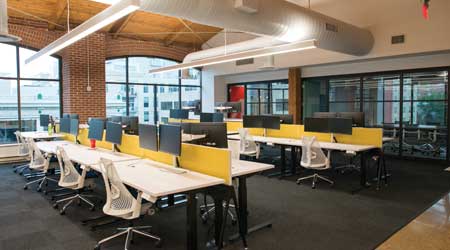 Networked lighting controls support quality lighting by tuning light level, brightness, and color output.
Networked lighting controls support quality lighting by tuning light level, brightness, and color output.What Should Be Included In a Networked Lighting Controls System?
The anatomy of an advanced lighting controls system can seem tricky. But here's how to simplify a system that offers multiple benefits.
A networked lighting control system consists of dimmable drivers or ballasts, accessory devices such as sensors and manual overrides, power controllers (which may be the driver or ballast), and supporting hardware and software used for system programming, communications, and data storage. Controllers are connected via dedicated control wiring or radio signals to build a network in which addressable control points can be controlled and programmed individually or in groups. The lighting controller, where the system’s intelligence (processing power) resides, may be distributed at each control point or centralized in a server or in the cloud. The system may be luminaire-, room-, building-, or campus-based.
Luminaire-based. Some manufacturers package control systems with LED luminaires to offer luminaire-based solutions. A controllable LED driver and sensors are embedded in each luminaire. While some luminaires are available with standalone controls for autonomous luminaire control, others communicate wirelessly and are preconfigured for simple commissioning. In some systems, individual luminaires can be grouped and programmed using a handheld remote.
Room-based. The majority of installed systems are room-based, in which lighting controls are installed as part of luminaires or remotely across a room and act as a single autonomous lighting control system. Installation is often plug and play for simplicity. The advantage of these systems is they produce instant energy savings with relatively simple design and commissioning. They are popular in new construction to gain out-of-the-box compliance with energy codes, which contain detailed requirements for a broad range of mandatory lighting controls.
Building-based. In terms of features and benefits, centralized building-based control systems are the most robust option. The advantage of this system is in the ability to program layered control strategies in detail, measure energy information for later retrieval and analysis, and monitoring to support maintenance operations. This option is more complex but offers potential to maximize energy reductions while delivering value for lighting control that goes far beyond saving energy.
Related Topics:














